Here Comes the Big Guy
Big ideas can come from small places or so they say. On March 2, 1884, American engineer and classmate of Gustav Eiffel, William Le Baron Jenney received permission to build what would be the first skyscraper in history. And it was perfect timing too, 1880s Chicago was a booming time for the city with new economic opportunities and a growing population. Plus, after a great fire swept through Chicago in October 1871, it made sense to start over and rebuild the city with iron instead of wood. Thus, it was pretty clear that new buildings needed to be made to accommodate for workers. The New York Home Insurance Company wanted a new headquarters in Chicago and not only did they want it to be fireproof, but tall. Jenney was chosen as the leading architect thanks to his design impressing the company. But at the time, many architects and experts scoffed at the idea at such a tall building and believed that it would be a failure. They were wrong.

Photograph of William Le Baron Jenney

The Home Insurance Company under construction
The Framework
In order to make the building, Jenney and his team created a frame made out of steel and iron. Not only did this make the building stronger and taller up to 10 stories, but it also made it lighter than most other traditionally made buildings. Previous methods in architecture required buildings to be supported by stone beams or walls and if they want to build taller, architects would have to make the walls thicker and heavier, which resulted in smaller windows and less light, a disadvantage as electricity would soon be widely used. The Home Insurance Building was supported by rolled steel beams and was decorated with Renaissance-like terracotta and stonework which protected the building from any sort of fire. The building had more windows thanks to the steel frame which allowed more light inside without reducing strength. Eventually, the Home Insurance Building was completed in 1885 and the overall cost was $300,000(around $7,700,000 in today’s money). Jenney’s use of a steel frame would be a revolutionary achievement in architecture and would influence future architects and soon, a new movement called the Chicago school would rise in America and become a symbol of US architecture in the late 19th to 20th century. Even though the building’s size was puny compared to future skyscrapers and was eventually demolished in 1931, Jenney’s work would set the standard for modern architecture.

Poster of the Home Insurance Building

The Big Guy completed
A Modern Skyscraper in its finest
The Taipei 101 in Taiwan was first constructed in 1999 and was designed by Taiwanese architect CY Lee. The skyscraper was eventually finished in 2003 and opened in October 2004. As the name implies, the building has 101 stories and is 508 meters tall and has managed to beat the skyscraper Kuala Lumpur in Malaysia in height, making it the world’s tallest building until being beaten out by the Burj Kalifa in the United Arab Emirates. Between the base and the spire, the building consists of eight grouping which what makes the building’s unique bamboo-like design. The skyscraper’s structural system contains 16 steel columns in its core and eight super-columns, both are made of steel and are filled with concrete until floor 62. The building is able to withstand seismic earthquakes and strong winds thanks to a 660-tonne damper that’s inside the building. The bottom floors are mostly luxury shopping mall and anything above it is primarily used for offices. The observatory is on floors 88 to 91 and is 392 meters above the ground making it the highest observatory in the world. The skyscraper has become one of Taiwan’s biggest tourist attraction mainly due it admittedly still impressive height and is also used for festivals like New Year’s. The overall cost of construction was $1.8 billion dollars and is actually managed by a company in Chicago.
taipeifinancial.jpg)
The Taipei 101

The breathtaking view from the building

The 660-tonne damper that is not only pretty to look at but also helps the building from swaying in typhoon winds

A look at the shopping malls
Sources
https://www.theguardian.com/cities/2015/apr/02/worlds-first-skyscraper-chicago-home-insurance-building-history
http://www.bbc.com/culture/story/20150930-chicago-birthplace-of-the-skyscraper
http://www.chicagotribune.com/news/nationworld/politics/chi-chicagodays-homeinsurance-story-story.html
http://www.architecture.org/learn/resources/architecture-dictionary/entry/william-le-baron-jenney/
https://www.businessinsider.com/taipei-101-worlds-most-expensive-building-2012-1#looks-like-a-pretty-swanky-shopping-center-13
https://www.britannica.com/place/Taipei-101
https://www.tripsavvy.com/taipei-101-tower-facts-1458242
Images
http://www.skyscrapercenter.com/building/taipei-101/117
https://www.businessinsider.com/taipei-101-worlds-most-expensive-building-2012-1#looks-like-a-pretty-swanky-shopping-center-13
Leave a Reply